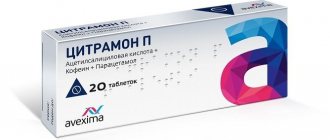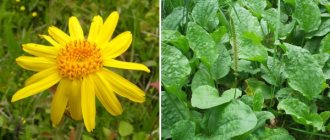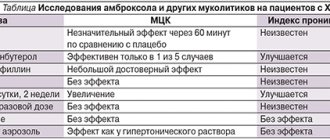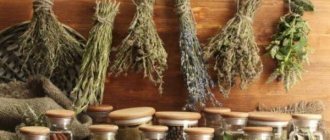Doctor MOM® herbal cough lozenges
For 1 lozenge:
Active substances
:
dry extracts isolated from:
Glycyrrhiza bare root (Glycyrrhiza glabra) - 15.0 mg
Ginger medicinal rhizomes (Zingiber officinale) - 10.0 mg
Emblica medicinal fruit (Emblica officinalis) - 10.0 mg and
Levomenthol - 7.0 mg
Excipients
:
— for orange lozenges
: sucrose 1618.0 mg, liquid dextrose 1037.0 mg, glycerol 1.5 mg, citric acid monohydrate 20.0 mg, methyl parahydroxybenzoate 5.0 mg, propyl parahydroxybenzoate 0.5 mg, orange flavor 4.07 mg, mint flavor ( mint essence) 0.012 mg, sunset yellow dye 0.125 mg;
— for lemon lozenges
: sucrose 1618, mg, liquid dextrose 1037.0 mg, glycerol 1.5 mg, citric acid monohydrate 25.0 mg, methyl parahydroxybenzoate 5.0 mg, propyl parahydroxybenzoate 0.5 mg, lemon oil 3.75 mg, mint flavor (mint essence) 0.125 mg, quinoline yellow dye 0.1 mg;
— for raspberry lozenges
: sucrose 1618.0 mg, liquid dextrose 1037.0 mg, glycerol 1.5 mg, methyl parahydroxybenzoate 5.0 mg, propyl parahydroxybenzoate 0.5 mg, raspberry flavor 6.25 mg, azorubine dye 0.1 mg;
— for strawberry lozenges:
sucrose 1618.0 mg, liquid dextrose 1037.0 mg, glycerol 1.5 mg, citric acid monohydrate 18.0 mg, methyl parahydroxybenzoate 5.0 mg, propyl parahydroxybenzoate 0.5 mg, strawberry flavor 7.5 mg, crimson dye (Ponceau 4R) 1.25 mg;
— for pineapple lozenges
: sucrose 1618.0 mg, liquid dextrose 1037.0 mg, glycerol 1.5 mg, citric acid monohydrate 2.0 mg, methyl parahydroxybenzoate 5.0 mg, propyl parahydroxybenzoate 0.5 mg, mint flavor (mint essence) 0.1 mg , pineapple flavor 6.25 mg, BQ Supra dye (mixture of brilliant blue dyes 0.0134 mg and quinoline yellow 0.0491 mg) 0.0625 mg;
— for fruit lozenges
: sucrose 1618.0 mg, liquid dextrose 1037.0 mg, glycerol 1.5 mg, citric acid monohydrate 5.0 mg, methyl parahydroxybenzoate 5.0 mg, propyl parahydroxybenzoate 0.5 mg, fruit flavor 7.0 mg, grape dye ( a mixture of brilliant blue dyes 0.022 mg and azorubine 0.162 mg) 0.184 mg;
— for berry lozenges
: sucrose 1618.0 mg, liquid dextrose 1037.0 mg, glycerol 1.5 mg, citric acid monohydrate 3.0 mg, methyl parahydroxybenzoate 5.0 mg, propyl parahydroxybenzoate 0.5 mg, berry flavor 7.0 mg, dyes: brilliant blue 0.005 mg and azorubine 0.025 mg.
Instructions for use DOCTOR MOM® (DOKTOR MOM®)
Combined preparation of plant origin; has bronchodilator, mucolytic, expectorant and anti-inflammatory effects.
Levomenthol
has a local irritant, analgesic, distracting, antipruritic and antiseptic effect. Antiseptic activity is manifested by indiscriminate damage to microbial cells. The irritating (distracting) effect helps reduce pain. The local effect is accompanied by vasoconstriction, a feeling of cold, turning into a feeling of slight burning and tingling.
Holy basil (Ocimum sanctum Linn.)
has a variety of pharmacological properties, providing hypoglycemic, immunomodulatory, anti-stress, analgesic, antipyretic, anti-inflammatory, antiulcer, antihypertensive effects and an inhibitory effect on the central nervous system, as well as radioprotective, antitumor and antibacterial effects. The leaves contain essential oils that contain eugenol, eugenal, carvacrol, methylcavicol, limarol and caryophylline. The seeds contain oil containing fatty acids and sitosterol. The supporting structures contain xylose and polysaccharides.
The antimicrobial effect of essential oil is shown against Mycobacterium tuberculosis and Staphylococcus aureus in vitro and against other types of bacteria and fungi. Eugenol and methyleugenol showed a pronounced effect. Adaptogenic (anti-stress) effect has been shown in mice and rats. The plant increased the physical resistance of the body and prevented the occurrence of stress-related ulcers. In general pharmacology, the aqueous extract showed a hypotensive effect and suppressed smooth muscle contractions caused by acetylcholine, carbachol and histamine. Protective effects against histamine-induced bronchospasm have been demonstrated in animals.
Licorice naked (Glycyrrhiza glabra Linn.)
The above-ground part of the plant contains tannins, essential oils, flavonoids, pigments, polysaccharides and saponins. Licorice roots and rhizomes - Radix Glycyrrhizae (previously called Radix Liquiritae), in addition to traces of essential oil, vitamins, proteins, bitter (up to 4%) and resinous (3-4%) substances, lipids (about 4%), polysaccharides (4- 6% pectin substances and starch), monosaccharides and disaccharides (up to 20% in total), contain flavonoids (3-4%) and triterpene saponins (about 20%) that are more interesting from a pharmacological point of view.
Licorice glabra has antimicrobial properties:
- ethereal and alcoholic extracts of roots in the experiment inhibit the growth of Candida albicans, Trichophyton gypseum and Microsporum lanosum. Moreover, alcohol extracts have less activity compared to ethereal ones. As evidenced by numerous modern studies, licorice has powerful antioxidant properties and also helps to effectively reduce blood cholesterol levels.
It has antipyretic properties, antimicrobial activity, and helps increase the synthesis of endogenous interferon.
Long turmeric (Curcuma longa Linn.)
contains essential oil (up to 5%), rich in sesquiterpenes - zingiberenes; yellow pigments such as curcumin. The powder of rhizomes is used as a spice, improves digestion, has a choleretic, diuretic and stimulating effect.
Ginger (Zingiber officinale Roscoe):
rhizomes of ginger (Rhizomata Zingiberis) contain essential oil (1-3%), the main component of which is sesquiterpenes - α- and β-zingiberenes;
- the burning taste is due to resinous substances - gingerols (5-8%). The use of ginger in the form of tincture gives good results in the treatment of gastric diseases. Ginger root is also used for stomach ulcers.
- 10) is prescribed for dysuria, half a teaspoon 2 times a day.
Ginger has high antimicrobial and antifungal properties. In India, ginger is used as a universal medicine that stimulates, softens, eliminates vomiting, flatulence, pain and inflammation of the joints, abdominal spasms, and also for gynecological diseases.
Adhatoda vasika Nees
It is used primarily as an anti-inflammatory, analgesic, expectorant, diuretic, anti-asthmatic and abortifacient, as an antiseptic and insecticide.
Indian nightshade (Solatium indicum Linn.)
is a plant that grows throughout India. The fruits and roots contain wax, fatty acids and the alkaloids solanine and solanidine. The plant has a cardiac stimulating, stimulating, astringent, carminative, cardiotonic and anti-inflammatory effect. Effective for bronchial asthma, dry cough, difficulty in labor, chronic febrile conditions, colic with bloating, parasitic diseases, scorpion stings, and dysuria. It is considered a diuretic, effective for edema, and an expectorant, effective for coughs and catarrhal diseases; also a diaphoretic and stimulant. The smoke of burning seeds is a remedy for toothache. In the form of a decoction (1:
Elecampane (Inula racemosa Hook f.)
contains sesquiterpene lactones alantolactone, isoalantolactone, inunal, isoalloantolactone, as well as essential oil. It has antispasmodic (reduces muscle spasms or cramps), beta-adrenergic blocking, hypotensive, antianginal effects.
Cube pepper (Pipercubeba Linn, fil.):
fruits are a good stimulant, especially for the kidneys and bladder;
Terminalia belerica Roxb.:
the fruits contain green fixed oil, saponin, tannins, resinous residue and 3 amorphous hygroscopic glycosidic substances.
Aloe Barbados (Aloe barbadensis, syn. Aloe indica Royle):
aloe juice and preparations based on it have strong anti-inflammatory and analgesic properties. As a drug for the treatment of inflammation, incl. purulent, aloe is widely used in surgery, dentistry, gynecology, therapy, otitis, diseases of the throat and nose, etc. The juice is especially helpful when taken orally for people suffering from gastrointestinal diseases:
- gastritis, duodenitis, inflammation of the gallbladder and biliary tract, stomach and duodenal ulcers, colitis, enterocolitis, intestinal atony and constipation. All these diseases are caused by inflammation of the mucous membranes, which disappears with the use of aloe juice.
The drug does not have a toxic or teratogenic effect in vivo.







